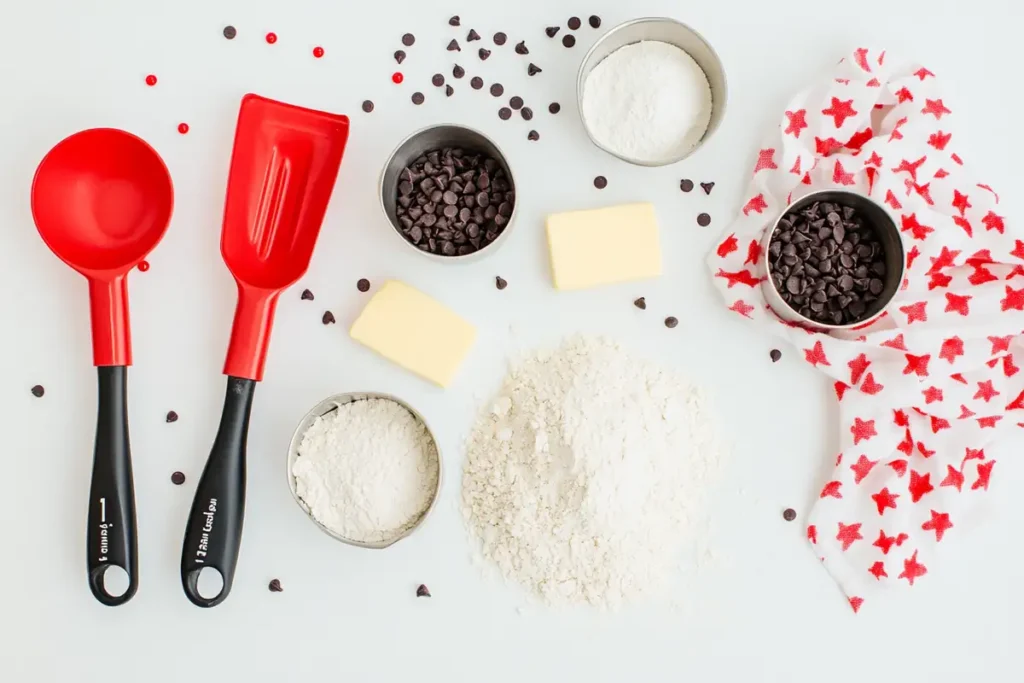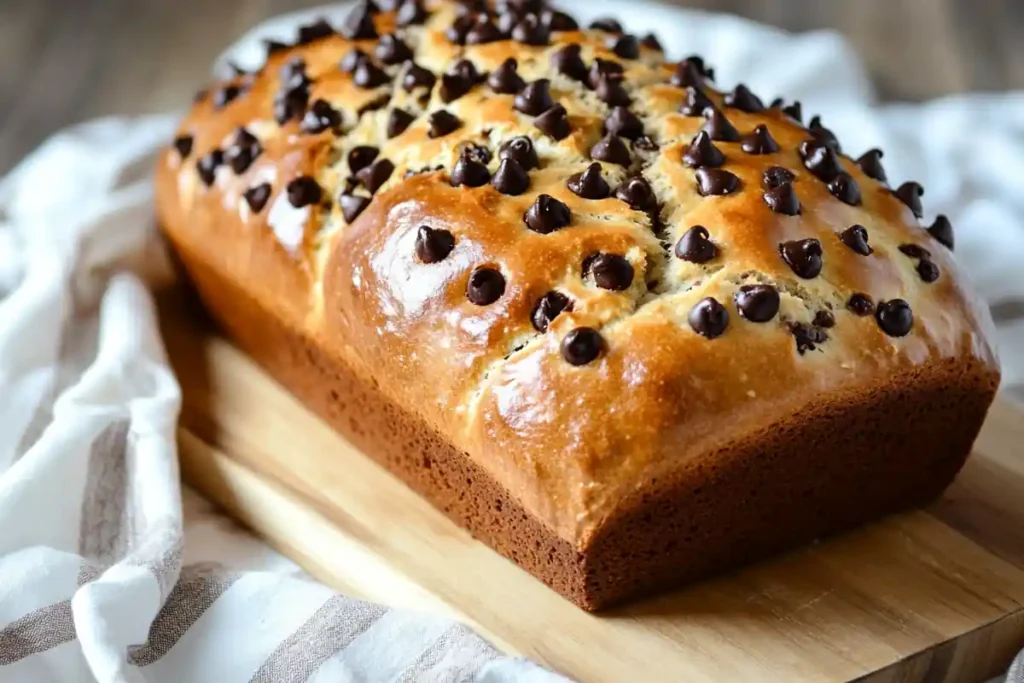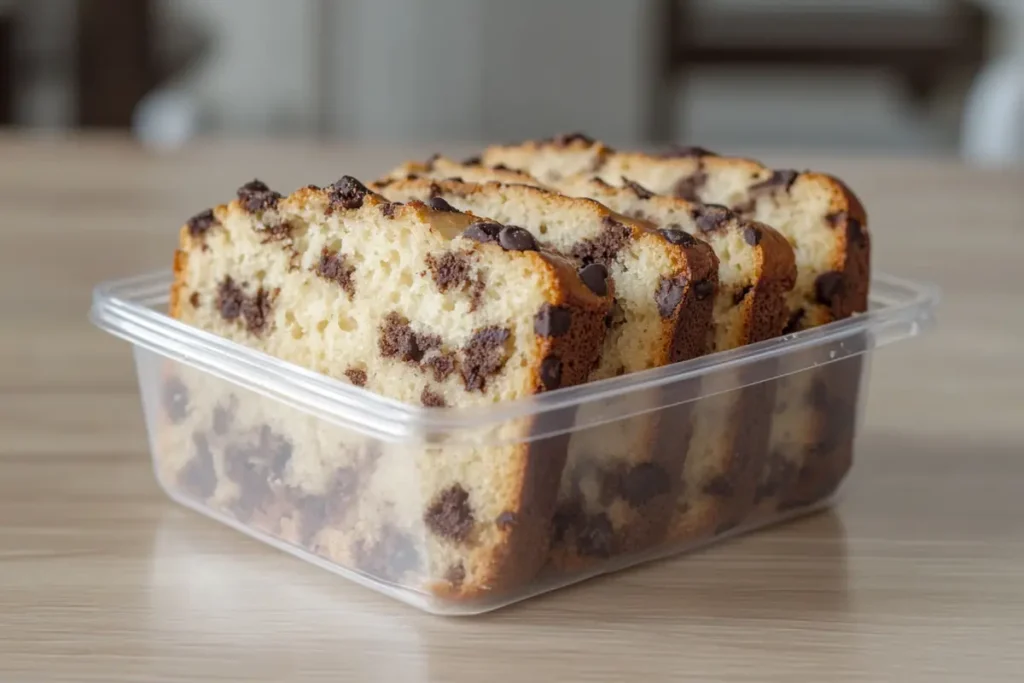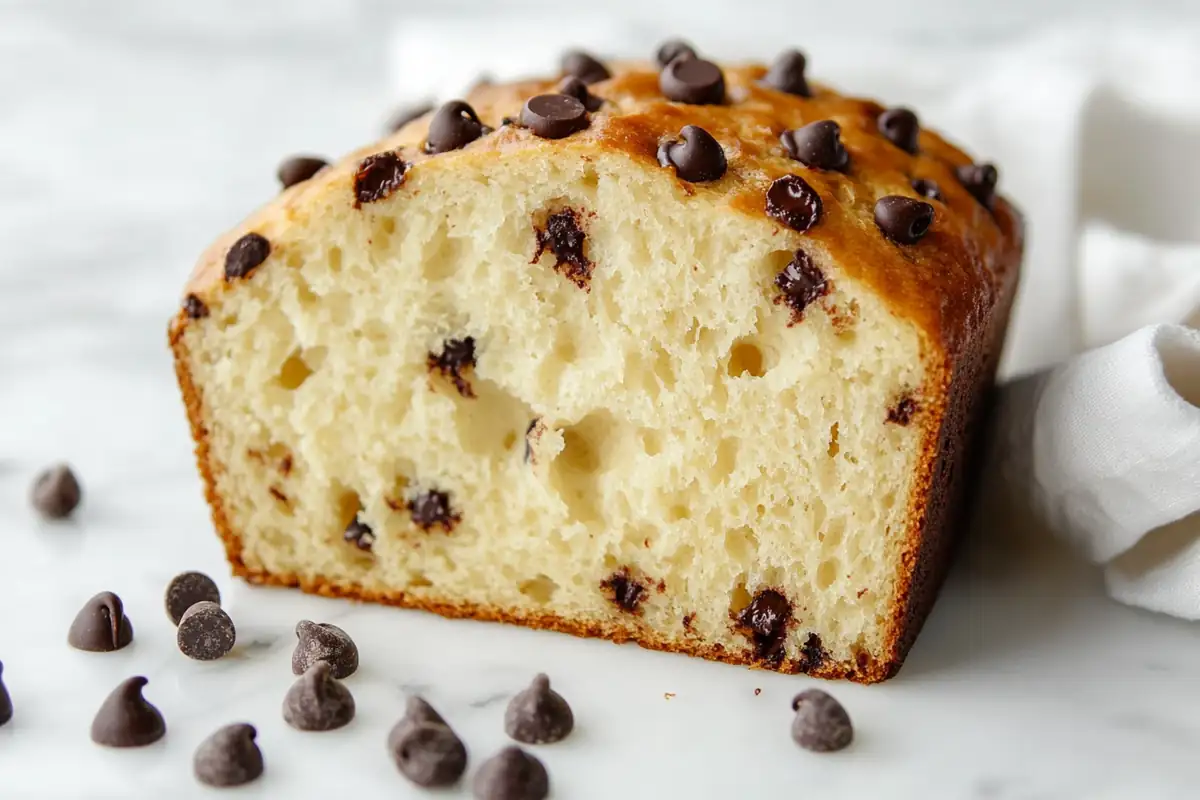Few things are as satisfying as a warm slice of chocolate chip bread fresh from the oven. But when that loaf turns out dry and crumbly, disappointment sets in. Dry bread isn’t just a random mishap—it’s usually the result of specific baking mistakes or environmental factors. In this article, we’ll dive into the common reasons for dryness, practical ways to prevent it, troubleshooting tips, and expert advice on enhancing both flavor and texture. By the end, you’ll have all the tools you need to consistently bake moist, flavorful chocolate chip bread
Understanding the Causes of Dry Chocolate Chip Bread
Why Is My Chocolate Chip Bread Dry?
Dry chocolate chip bread often stems from issues with ingredient proportions, baking techniques, or environmental factors. While chocolate chips might add sweetness and a bit of moisture, the bread’s texture relies heavily on a balance of liquids, fats, and baking methods.
Common Causes of Dryness in Chocolate Chip Bread
Incorrect Flour-to-Liquid Ratios
Flour is the backbone of any bread recipe, but too much can wreak havoc on texture. When there’s an imbalance between flour and liquid, the dough becomes stiff, leading to a dry loaf. Always measure your ingredients precisely using a kitchen scale for the best results. For bread recipes, remember that proper dough hydration is critical.
Overmixing the Dough
It’s tempting to mix thoroughly, but overmixing activates gluten in flour, making bread dense and dry. A few too many stirs, and suddenly your loaf resembles rubber more than bread. To avoid this, mix the ingredients until just combined. Overmixing dough, particularly when making quick breads, is a surefire way to lose that desired lightness.
Insufficient Fat Content
Fats, such as butter or oil, are essential for soft, moist bread. If your recipe skimps on fat, the bread won’t retain enough moisture. Think of fat as the “glue” that holds the flavor and texture together. Ensure you’re using the recommended amounts, as fat provides richness while preventing dry bread issues.
Overbaking the Bread
One of the biggest culprits of dry chocolate chip bread is overbaking. Even a few extra minutes in the oven can zap the bread of its moisture. Bake until a toothpick inserted in the center comes out with a few moist crumbs—not bone dry. Adjust your baking time if you notice your bread consistently turning out dry.
Environmental Factors Affecting Moisture
Humidity—or the lack of it—can significantly impact your bread. Dry air pulls moisture from your loaf faster, especially during storage. Similarly, high altitudes require tweaks in recipes to account for differences in air pressure. For bakers in arid or high-altitude areas, adding extra liquid or reducing oven temperature slightly can make a noticeable difference.
Preventing Dryness in Chocolate Chip Bread
When it comes to baking the perfect loaf of chocolate chip bread, preventing dryness is all about mastering the details. By refining your technique and tailoring your recipe, you can ensure your bread stays soft, tender, and irresistibly moist. Let’s delve into some tried-and-true methods.
Techniques to Maintain Moisture in Your Bread
Accurate Measurement of Ingredients

Precision is everything in baking. Even a slight miscalculation can mean the difference between moist bread and a dry, crumbly mess. Flour, for instance, is notorious for being over-measured when scooped directly with a cup, leading to excess dryness. Always use a kitchen scale for accuracy, especially with dough hydration-sensitive ingredients. When measuring liquids, use a clear measuring cup and view it at eye level to avoid errors. Precision in fats and sugars is equally important, as these ingredients enhance both flavor and moisture retention. Consistency in your measurements builds a strong foundation for any recipe.
Proper Mixing and Kneading Practices
The way you mix and knead your dough determines its final texture. Overmixing may seem harmless, but it leads to excessive gluten development, which toughens and dries out your bread. Instead, mix just until the ingredients are combined, particularly for quick breads like chocolate chip bread. If your recipe calls for kneading, do so gently, aiming for a soft, elastic dough. Remember, less is often more when handling dough. This simple adjustment prevents overworked dough and encourages a lighter, moist bread texture.
Adjusting Baking Times and Temperatures
Even the perfect batter can suffer if baking times or temperatures are off. An oven that’s too hot can cook the outside too quickly while leaving the inside dry. Conversely, baking too long, even at the right temperature, can sap your bread of its natural moisture. To avoid these pitfalls, always preheat your oven and use an oven thermometer to ensure accuracy. Begin checking your bread for doneness a few minutes before the suggested time. A toothpick inserted into the center should come out with a few crumbs, not completely clean. For an extra layer of protection, consider tenting the top with foil halfway through baking to prevent over-browning.
Enhancing Moisture with Additional Ingredients

Sometimes, it’s all about the extras. Ingredients like yogurt, sour cream, mashed bananas, or applesauce can work wonders for your bread’s moisture levels. These additions not only enrich the texture but also infuse subtle flavors that elevate the overall experience. For example, yogurt’s creamy texture adds both tenderness and acidity, which can improve the dough’s rise. Similarly, mashed fruits bring natural sugars and moisture to the mix. Adding moisture-rich ingredients like these creates a bread that’s soft, fluffy, and packed with flavor—perfect for avoiding dry bread issues.
Adapting to Environmental Conditions
Baking is as much science as it is art, and your environment plays a significant role. High altitudes, with lower air pressure, can cause breads to rise too quickly and lose moisture. Adjust by slightly reducing sugar and increasing liquids in your recipe. In contrast, dry or arid climates may require you to cover your dough during proofing to prevent it from drying out. Meanwhile, humid environments might need adjustments in baking times to avoid soggy textures. Embrace these tweaks to keep your chocolate chip bread moist no matter where you’re baking.
Troubleshooting and Enhancing Your Chocolate Chip Bread
Even with the best intentions, chocolate chip bread doesn’t always turn out as planned. Whether it’s a loaf that’s too dry or one lacking in flavor, there are solutions and enhancements that can save the day. Here’s how to troubleshoot common problems and boost the taste and texture of your bread.
Troubleshooting Dry Chocolate Chip Bread
Identifying Signs of Dryness
The first step in addressing dry bread is recognizing it early. Is your loaf crumbling excessively when sliced? Does it feel dense and heavy instead of soft and springy? Dry bread often appears dull rather than slightly glossy, and it may lack the inviting aroma of properly hydrated dough. These indicators suggest issues like insufficient dough hydration or overbaking. Identifying the signs quickly allows you to adjust your techniques in the next bake.
Remedies for Dry Bread
If your bread has already baked and feels dry, don’t despair. There are several ways to restore moisture. Lightly steaming slices over simmering water or microwaving them with a damp paper towel can rejuvenate texture. Additionally, brushing the loaf with sugar syrup or melted butter immediately after baking creates a barrier to lock in moisture. For loaves that are dry during storage, reheating them in foil helps refresh softness while avoiding further dryness. These methods breathe life back into bread that might otherwise seem unsalvageable.
Storing Bread to Preserve Moisture

Proper storage is essential for keeping bread fresh. Avoid leaving your loaf exposed to air, as this accelerates moisture loss. Wrapping bread tightly in plastic wrap or aluminum foil creates a protective barrier. For long-term storage, consider freezing your loaf; slice it beforehand for easy access to individual portions. Airtight containers or resealable bags with a paper towel inside can absorb excess humidity and prevent sogginess. By investing a little effort in storage, you can extend the life and softness of your chocolate chip bread.
Enhancing Flavor and Texture
Incorporating Moisture-Rich Ingredients
Adding ingredients that naturally retain moisture can significantly enhance your bread. Fruits like bananas, apples, or even grated zucchini introduce hydration and a touch of natural sweetness. Custards and syrups, such as honey or maple syrup, not only boost moisture but also complement the chocolatey richness of the chips. These tweaks are particularly helpful for recipes that may lean on the dry side due to flour-heavy formulations. By incorporating these elements, you can transform a basic loaf into a luscious, flavorful treat.
Experimenting with Different Fats and Sugars
The fats and sugars you use can redefine the texture and taste of your bread. Swapping butter for coconut oil, for instance, adds a tropical aroma and creamy texture. Using brown sugar instead of white introduces molasses-like richness and extra moisture retention. Similarly, replacing a portion of sugar with honey or agave syrup yields a softer crumb. These small adjustments can make your bread not only moister but also more nuanced in flavor, ensuring each slice is both delicious and indulgent.
Conclusion
Baking chocolate chip bread that is consistently moist and delicious is entirely achievable with the right techniques and attention to detail. If you’ve ever wondered, “Why is my chocolate chip bread dry?”, the answer lies in addressing factors like accurate ingredient measurements, avoiding overmixing, maintaining proper baking times, and adapting to environmental conditions. By incorporating moisture-rich ingredients such as yogurt or mashed fruits and ensuring careful storage, you can prevent dryness and extend the bread’s freshness.
Remember, every recipe is an opportunity to learn. Adjusting for altitude, humidity, or even personal taste preferences allows you to perfect your craft. With these actionable solutions, you’re now equipped to bake soft, flavorful chocolate chip bread that delights every time. Whether you’re a seasoned baker or just starting, these tips will transform your baking into a consistently rewarding experience. Happy baking!
Frequently Asked Questions
Chocolate chip bread raises plenty of questions for bakers, from ingredient swaps to solving common baking dilemmas. Below, we answer some of the most frequently asked questions to help you troubleshoot and refine your baking skills.
Is Baker’s chocolate the same as chocolate chips?
No, Baker’s chocolate and chocolate chips are not the same, although both are staples in baking. Baker’s chocolate is unsweetened or semi-sweet and typically sold in blocks, making it ideal for recipes where controlling sugar content is essential. Chocolate chips, on the other hand, are sweetened and contain stabilizers that help them retain their shape when baked. If you’re substituting one for the other, remember that Baker’s chocolate might need additional sugar to balance flavors, while chocolate chips might melt less evenly due to their design.
How do you eat chocolate chip brioche?
Chocolate chip brioche is best enjoyed fresh, warm, and straight from the oven. Slice it thickly and serve with a pat of softened butter for a decadent breakfast or snack. Alternatively, you can toast slices and drizzle them with honey or chocolate syrup for an extra indulgent treat. Another option is to transform brioche into French toast—its rich, slightly sweet flavor pairs perfectly with custards. Brioche’s versatility means there’s no wrong way to enjoy it, whether as a dessert or an accompaniment to coffee.
Why did my chocolate chips sink to the bottom of my bread?
When chocolate chips sink, it’s usually due to overly thin batter or improper mixing. A batter that’s too wet lacks the structure to suspend heavier ingredients like chocolate chips. To avoid this, toss the chips in a small amount of flour before folding them into the dough. This simple trick helps them adhere to the batter and remain evenly distributed. Additionally, be careful not to overmix, as overmixing can weaken the dough’s integrity, allowing chips to sink to the bottom.
What makes bread super soft and fluffy?
Soft, fluffy bread is a result of a well-balanced recipe and proper technique. Hydration is key—ensure the liquid-to-flour ratio is sufficient to create a moist dough. Fats like butter or oil contribute richness, while sugars enhance flavor and feed the yeast, leading to better rise. Proper kneading also develops the gluten structure necessary for a light crumb. Finally, allow the bread to rise fully before baking; rushing this step can result in a dense texture. Incorporating techniques like these ensures your bread is irresistibly soft.
What happened to Baker’s chocolate?
Baker’s chocolate remains a popular choice among home and professional bakers alike. However, some consumers have noticed subtle changes in its formula or packaging over the years, as manufacturers adapt to trends and availability of ingredients. Despite these updates, Baker’s chocolate remains a reliable choice for recipes that call for unsweetened or semi-sweet chocolate. If you’re concerned about specific qualities, checking the product label can help ensure it meets your needs.
Can I use melted chocolate chips instead of cocoa?
Yes, you can use melted chocolate chips as a substitute for cocoa powder, but adjustments may be necessary. Chocolate chips contain added sugar and stabilizers, so you’ll need to reduce the sweeteners in your recipe to balance flavors. Melted chips also add fat, which can slightly alter the texture of your bread. If you’re substituting for a dry cocoa powder, remember to decrease the liquid ingredients to account for the added moisture from the melted chocolate. This swap works best in recipes that can accommodate richer textures.

